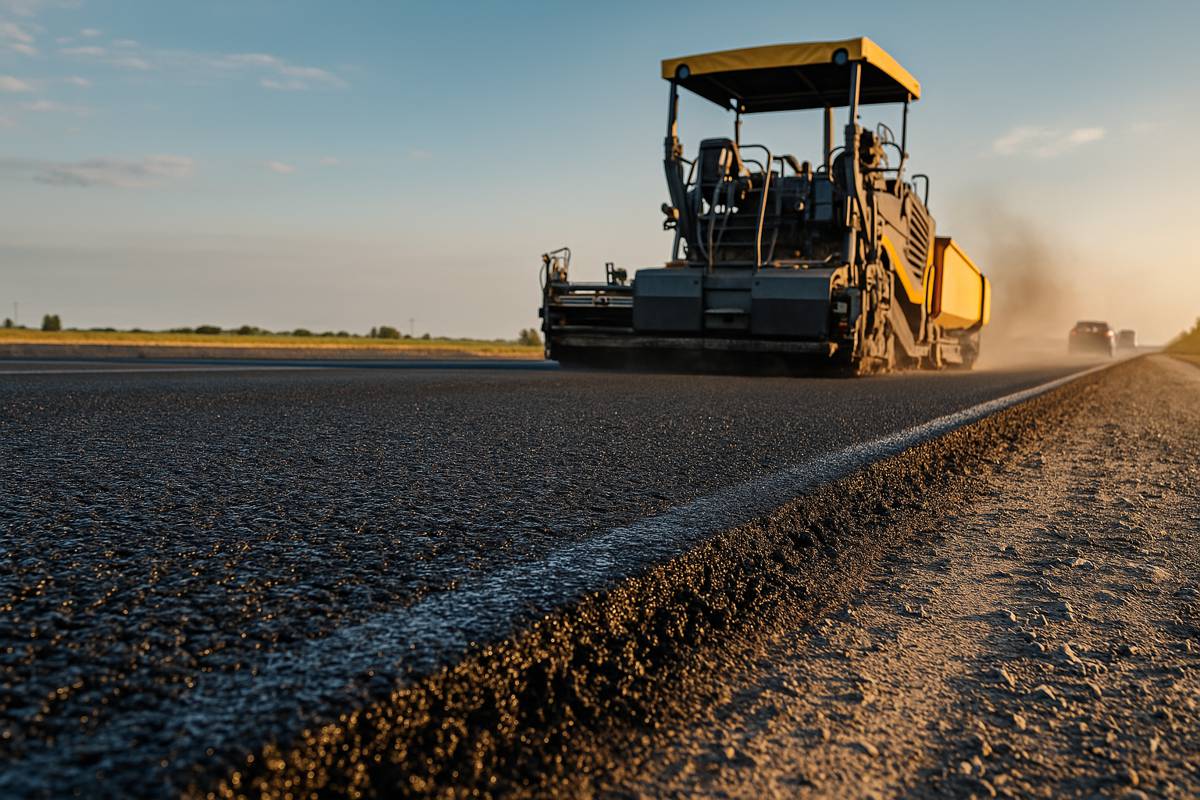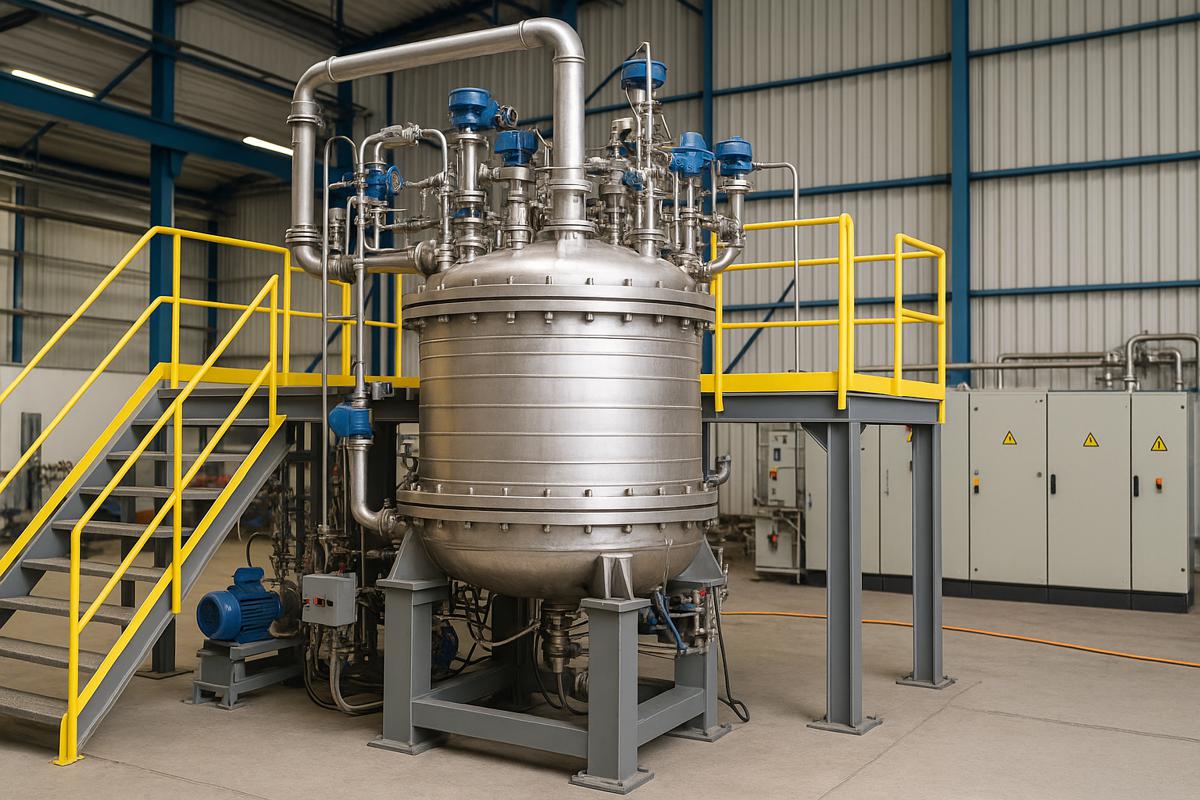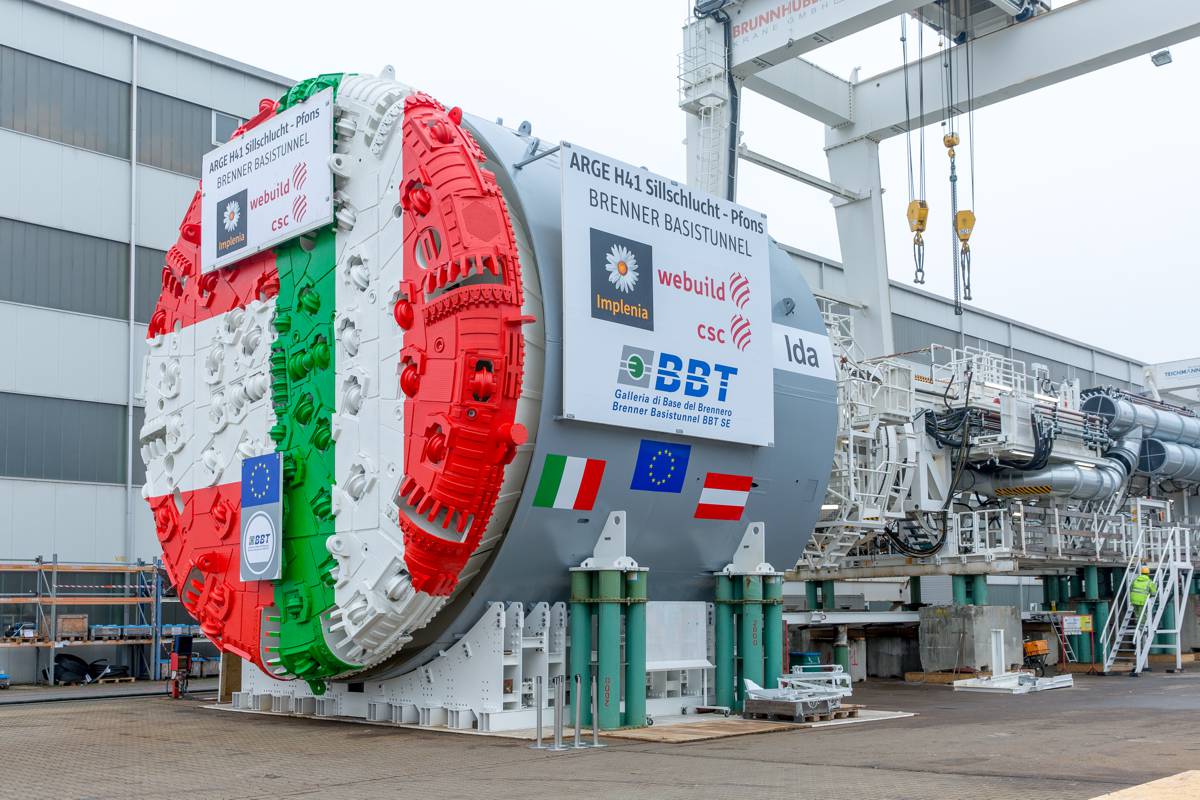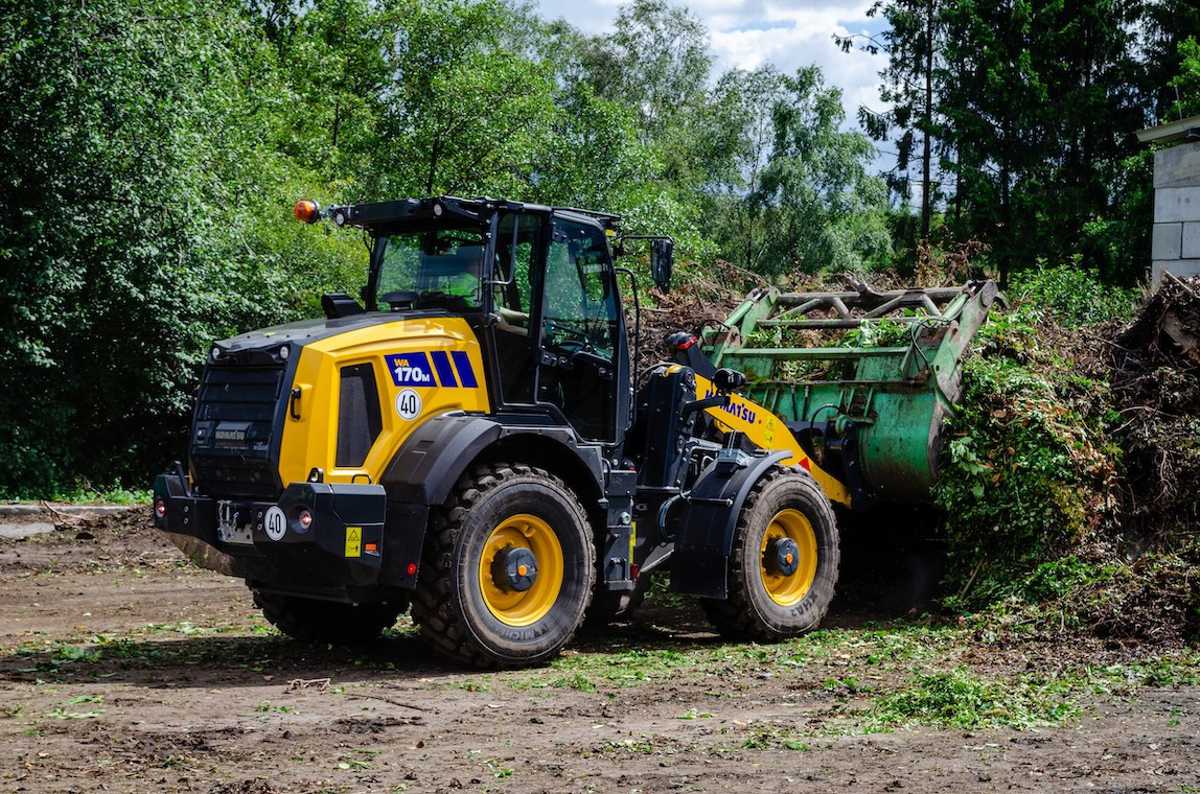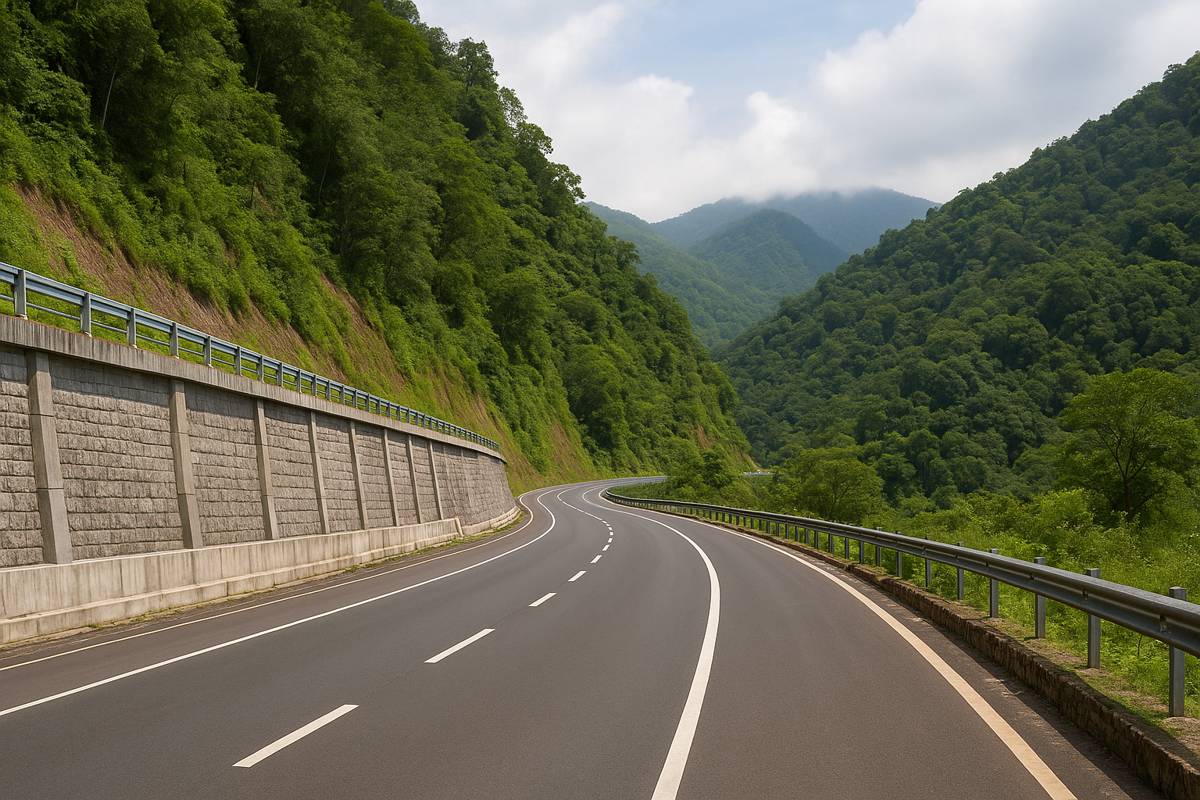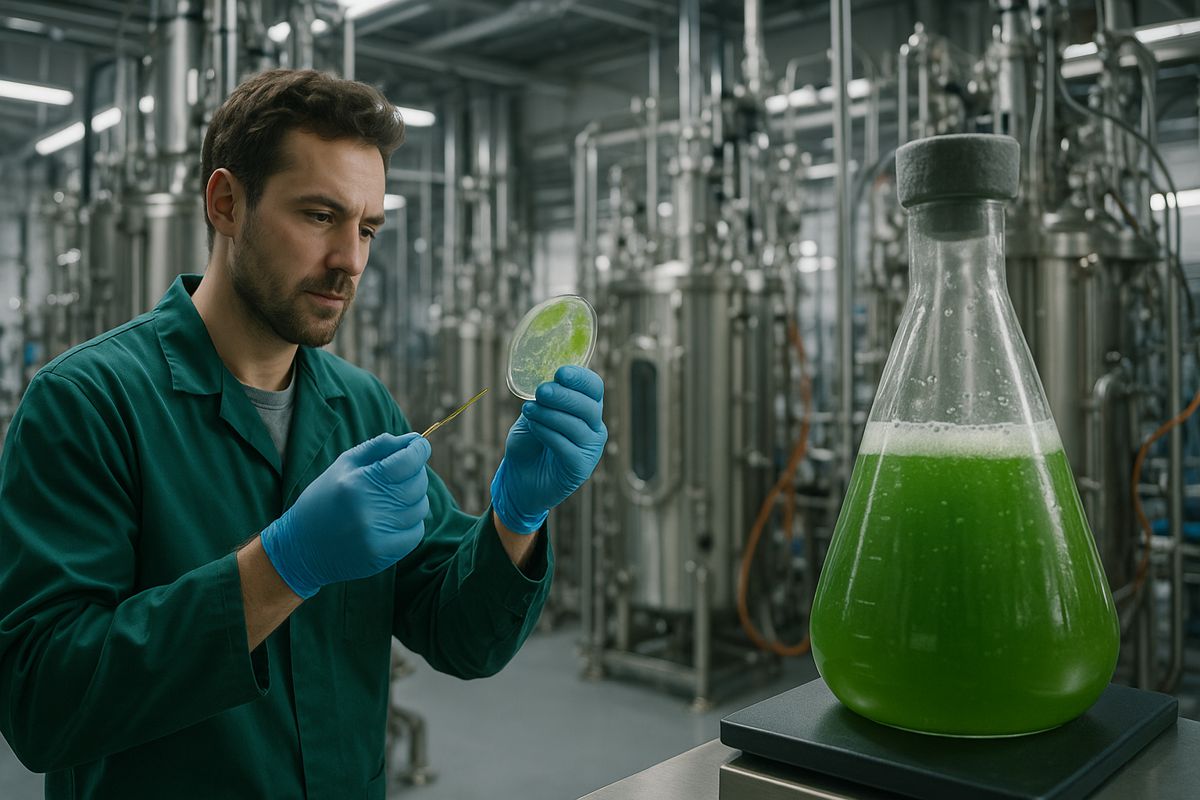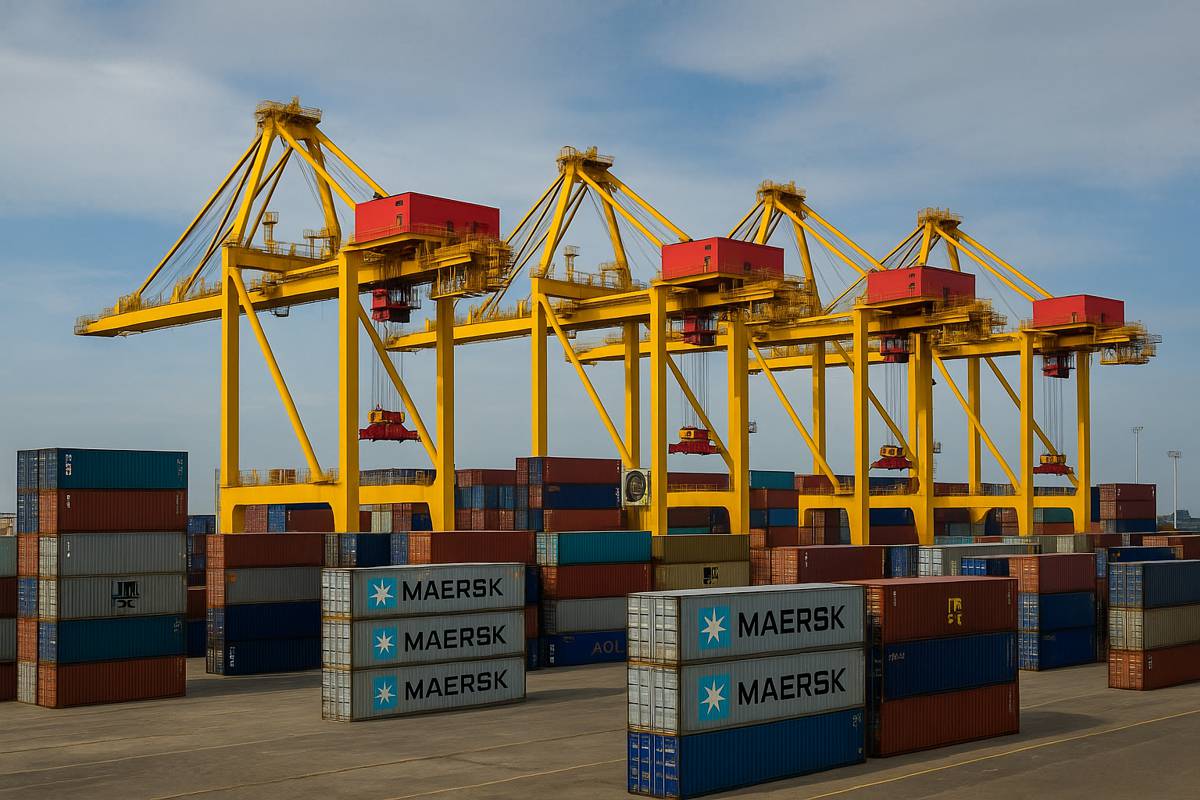Bitumen and Asphalt in a Changing World
Across the globe, tens of millions of kilometres of roads stitch together cities, towns, and villages, with asphalt as the literal groundwork of development. Asphalt (also known as bituminous pavement) is essentially a mixture of mineral aggregate and bitumen binder. Bitumen itself is a heavy viscous form of petroleum, often a by-product of crude oil refining, sometimes called “black gold” for its value and origin.
This black, tarry binder has been indispensable for modern infrastructure: over 90% of paved roads worldwide are surfaced with asphalt, prized for its durability and flexibility. Yet, as essential as asphalt is to mobility and economic growth, the way we build and maintain roads is facing a crossroads. Climate change, environmental pressures, and the quest for more sustainable infrastructure are prompting a reimagining of bitumen and asphalt on a global scale.
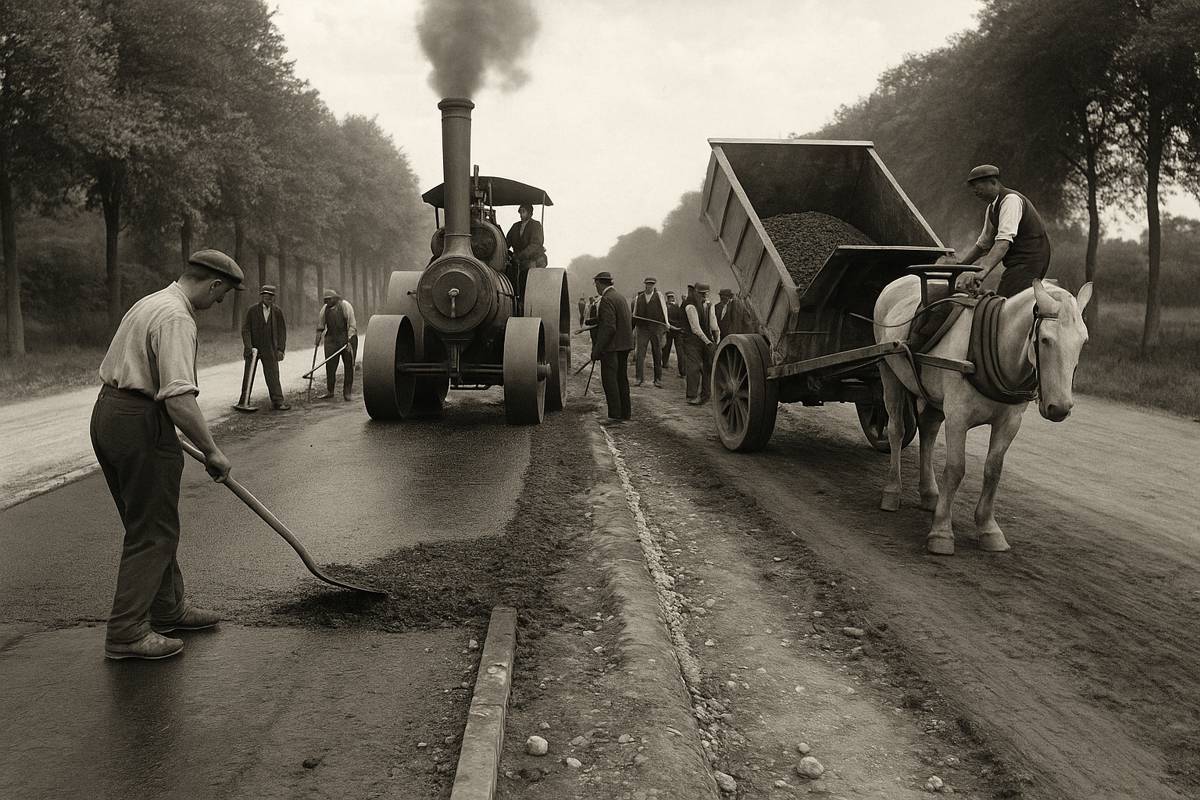
A Brief History and the Global Role of Bitumen
Bitumen’s use in construction is far from new, in fact, it dates back to antiquity. Archaeological evidence shows that as early as 40,000 years ago humans were using natural bitumen (from tar pits or seeps) as an adhesive, for example to attach stone tool heads to handles. In the ancient Near East, civilizations like the Sumerians used natural bitumen for mortar, waterproofing and ship caulking, and the substance even found a role in Egyptian mummification and the sealing of Babylon’s walls. Fast forward to the 19th century, and bitumen was being adopted in Europe for paving city streets, notably in France, marking the start of its extensive use in modern road infrastructure.
Today, bitumen is a cornerstone of road construction, accounting for roughly 70% of annual global bitumen production (most of the rest is used in roofing and waterproofing). It is produced both from refining crude oil and obtained from natural deposits. In refining, bitumen is essentially the heaviest fraction of crude: after lighter fuels like gasoline and diesel are distilled off, a thick residue remains. This residue is further processed (e.g. vacuum distillation and de-asphalting) to yield bitumen of the required consistency.
In essence, “bitumen is a waste product from the oil industry”, the bottom of the barrel that, rather than being discarded, becomes a valuable construction material. Natural sources of bitumen also exist, such as the famous Pitch Lake in Trinidad (the world’s largest natural asphalt lake, containing ~10 million tons of bitumen) and the tar sands of Alberta, Canada. These natural bitumens have been used for centuries and continue to contribute to supply, though the majority of road asphalt binder today comes from petroleum refining.
From a global perspective, the scale of asphalt usage is enormous. The world’s road network is estimated at over 64 million kilometres, and asphalt’s prevalence is due to its advantageous properties: it provides a smooth, durable driving surface, it’s flexible enough to withstand heavy loads without cracking (when designed properly), and importantly, asphalt is 100% recyclable. Old road asphalt can be milled off, reheated, and mixed into new pavement, an attribute that has made asphalt the most recycled material in the world by volume.
This recyclability and proven performance have cemented asphalt’s role as the default paving material in most countries. However, the very characteristics that made asphalt king of the roads in the 20th century also pose challenges in the 21st: asphalt’s petroleum origins tie it to fossil fuel emissions, and its susceptibility to temperature means it may struggle under the extremes of a changing climate.
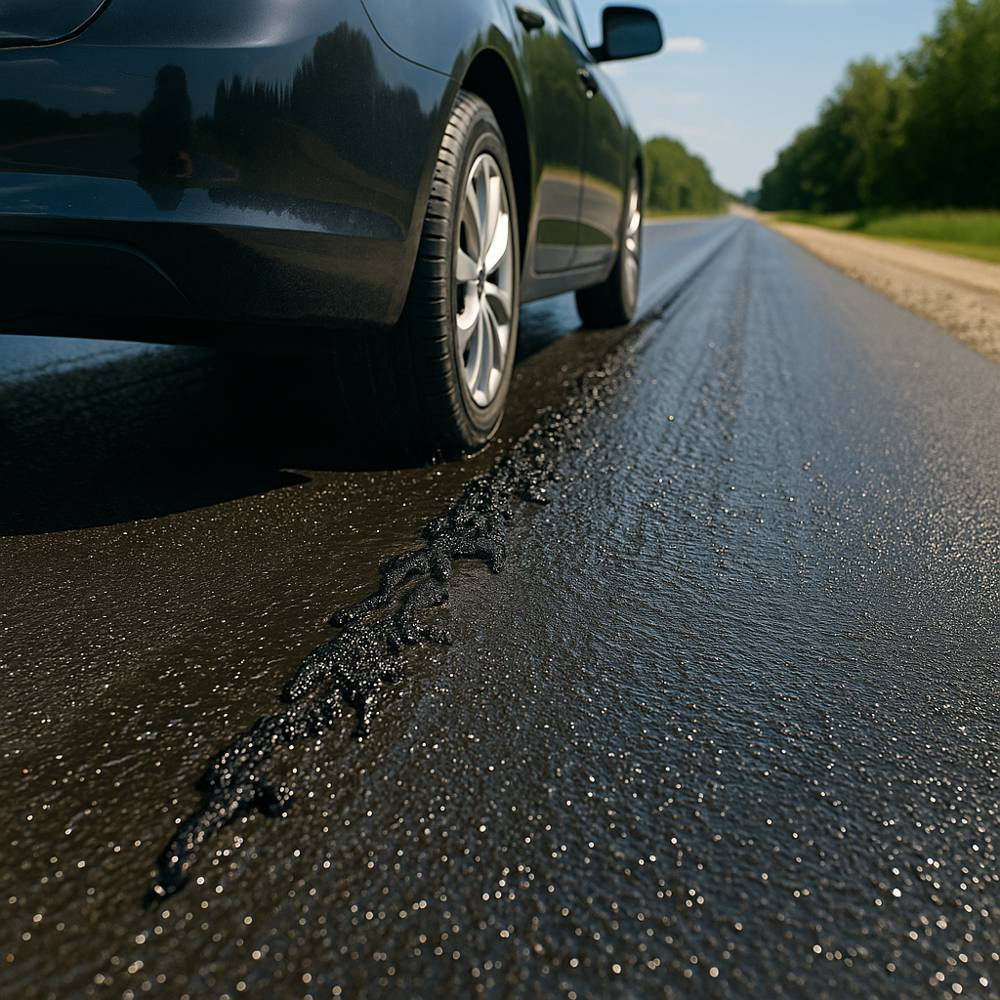
Heat, Floods, and the Strain on Asphalt
The impact of climate change on road infrastructure has become alarmingly evident around the world. Highways and streets built for 20th-century weather patterns are increasingly buckling, melting, or washing away under unprecedented heat and rainfall. For example, in California, the iconic coastal Highway One has been repeatedly closed by landslides after fierce storms.
A series of “atmospheric river” deluges in 2023 pummelled California’s coast with torrential rains, overwhelming drainage and destabilizing slopes, sections of highway simply collapsed. As one engineering expert noted, “when they engineered these roads, they made big assumptions that we weren’t going to have big changes in precipitation”, assumptions now invalidated by a warming climate. In his words, “we literally built the roads on the edge of land,” and those edges are crumbling under nature’s fury.
Similarly, once-in-a-century floods have devastated roads in places like Germany and China in recent years, while low-lying coastal roads in Southeast Asia are routinely inundated by rising seas and storm surges.
Heat is an equally formidable foe. In the summer of 2022, Britain, a country with a traditionally temperate climate, saw an unprecedented heatwave topping 40 °C. Many older roadways in the UK literally began to melt. The tar in aged asphalt pavements softened, turning some roads “soft and greasy, and it is difficult for cars to brake,” explained Prof. Xiangming Zhou of Brunel University. Some surfaces became sticky or deformed, to the point that several local roads had to be dusted with sand (normally used for icy conditions) to provide traction.
Even critical infrastructure was impacted, at London’s Luton Airport, part of a runway “lifted” and buckled in the extreme heat, forcing a closure. Modern highways with polymer-modified binders are designed to handle higher temperatures (British motorways use grades aiming up to ~60 °C surface temps), but local roads with older asphalt weren’t so fortunate in that heatwave. As Rick Green, chairman of the UK Asphalt Industry Alliance, noted, designing pavements that can withstand both severe cold and extreme heat is “a significant challenge for design engineers” with standard bitumen softening in extreme heat, increasing the risk of ruts and potholes if not modified.
Elsewhere, heatwaves in the United States have caused asphalt to expand and crack or even “explode” in blowouts. In Phoenix, Arizona, now the hottest large city in the U.S., vast expanses of black asphalt have contributed to a dangerous urban heat island effect. With about 30-40% of Phoenix’s land area covered by pavement, summer surface temperatures on asphalt can reach astonishing levels (70 °C or more), raising ambient temperatures further and even heating the air above the road.
Such conditions aren’t just a health hazard; they accelerate pavement damage. The extreme thermal expansion and softening can lead to pavement buckling and deformation. Meanwhile, sudden heavy rains can be just as destructive in a hot climate: after long dry spells, flash floods in paved urban areas cause intense runoff, eroding road foundations and causing washouts if drainage is insufficient.
Around the world, the new normal is that old design assumptions no longer hold, what was historically a 50-year storm or a record heat is becoming relatively frequent. An analysis cited in one study warned that failing to climate-proof roads could add an extra 3-9% to road construction and maintenance costs over just the next 30 years, an economic strain on top of the physical damage.

Cool Pavements and Porous Asphalt
In response to these climate, pressures, engineers and cities worldwide are experimenting with new ways to make roads more resilient. One strategy in heat-prone areas is deploying “cool pavements”, special surface treatments that reflect more sunlight and absorb less heat. Los Angeles was an early pioneer, coating some streets with a light-grey reflective seal. Now Phoenix has one of the largest trials: over 100 miles of streets painted with a grey-white cool coating. The results are promising, treated road surfaces in Phoenix are on average 10-12 °F cooler in the afternoon than neighbouring black asphalt, and up to 18 °F cooler on the hottest days.
In San Antonio, Texas, where climate projections show many more 100°F+ days ahead, the city launched similar pilots after a brutal summer in 2022. “Climate change is no longer something that’s in the future. It’s here now,” said Douglas Melnick, San Antonio’s Chief Sustainability Officer, underscoring why they’re testing reflective road coatings alongside planting more street trees. Early data from San Antonio showed a high-reflectivity coating reduced pavement surface temps by ~3.5 °F on average (and much more versus fresh black asphalt).
By keeping asphalt cooler, these coatings can slow binder softening and rutting, potentially prolonging pavement life while also improving comfort for pedestrians and drivers. Engineers do caution that cool pavements aren’t a cure-all, they work best in sunny, open areas, and reflecting heat can slightly warm the immediate air (potentially affecting pedestrians). Still, cities from California to Australia are exploring reflective asphalt technologies, often with support from national grants, as part of the toolbox for heat-resilient infrastructure.
Water management is another focus area, especially as intense downpours become more common. Traditional dense asphalt is impervious, it causes water to run off quickly, which can overwhelm drains and cause flash floods. Enter permeable asphalt: a specially designed porous pavement that lets rainwater seep through into the ground below. Permeable (or porous) asphalt contains interconnected voids that act like a sponge during storms. Instead of turning streets into rivers, a well-designed permeable roadbed can absorb and infiltrate heavy rainfall, reducing surface runoff dramatically.
This not only helps prevent urban flooding, but also recharges groundwater and reduces the need for large stormwater infrastructure. Permeable pavements have existed for years (often used in parking lots or low-traffic areas), but new formulations are improving their strength so they can handle heavier loads and more traffic. In flood-prone cities and coastal areas, some road projects now incorporate porous asphalt sections to improve drainage.
The dual benefit is improved safety, by minimizing standing water, these pavements reduce hydroplaning and provide better traction during storms. As climate change brings more monsoon-like rains, many experts forecast that “cities will turn to permeable asphalt as part of their green infrastructure initiatives,” using roads themselves as a defence against flooding.
From heat-reflective coatings to rain-sponge roads, such adaptations will be essential to keep our transportation networks operational in a more volatile climate.

The Carbon Footprint of Asphalt
Adaptation is only half the battle, the asphalt industry also faces a carbon footprint conundrum. Bitumen, the binder in asphalt, is derived from petroleum, and the processes of producing asphalt and paving roads are energy-intensive and emissions-heavy. Consider what it takes to build a highway: rocks (aggregate) must be mined or quarried, transported, dried and heated; bitumen must be heated (often to ~150-170 °C for hot mix asphalt) and combined with the aggregate; the asphalt mix is trucked to the site and laid while hot.
Every step, mining, hauling, burning fuel for dryers and burners, consumes energy and emits greenhouse gases. In the United States, it’s estimated that the “cradle-to-gate” emissions from asphalt mix production account for about 0.3% of total U.S. GHG emissions (circa 2019). That might sound small percentage-wise, but given the vast scale of roads (the U.S. has over 6.6 million km of roads), it amounts to a significant volume of CO₂. Globally, when you add up all countries’ road-building, asphalt-related emissions are a non-trivial piece of the construction emissions pie.
Moreover, asphalt’s climate impact isn’t just from its production; paved surfaces themselves affect the environment. Dark asphalt absorbs sunlight and radiates heat, contributing to the urban heat island effect, which in turn drives up energy use for cooling in cities. Studies even show that asphalt can emit volatile organic compounds (VOCs) on hot sunny days, essentially smog ingredients released from the binder when it gets hot.
Maintaining asphalt also has a carbon cost: frequently repaving or patching roads means more production of asphalt and materials over a roadway’s life cycle. And at end-of-life, if old asphalt (known as reclaimed asphalt pavement, RAP) isn’t recycled, it has to be transported and disposed of (or stockpiled), again adding to environmental burden.
Traditionally, asphalt has been seen as the lesser of two evils compared to its main rival, concrete. Concrete (made with Portland cement) has an even higher carbon footprint per ton, with cement production one of the largest industrial sources of CO₂. Indeed, some analyses argue that building a road with asphalt can result in lower lifecycle emissions than building it with concrete.
One study by the Asphalt Pavement Alliance claimed that over a typical lifespan, an asphalt road might produce only ~30% of the greenhouse gases of a comparable concrete road. However, being slightly greener than concrete is not an excuse for complacency. Both asphalt and concrete industries are under pressure to radically reduce their carbon emissions. For asphalt, this means rethinking materials and methods to shrink the embodied carbon (the emissions associated with producing and constructing the pavement) as well as the operational impacts (like the heat island effect or vehicle fuel efficiency on rough vs. smooth surfaces).
The encouraging news is that asphalt, sometimes dubbed “infinitely recyclable”, has pathways to become significantly more sustainable.
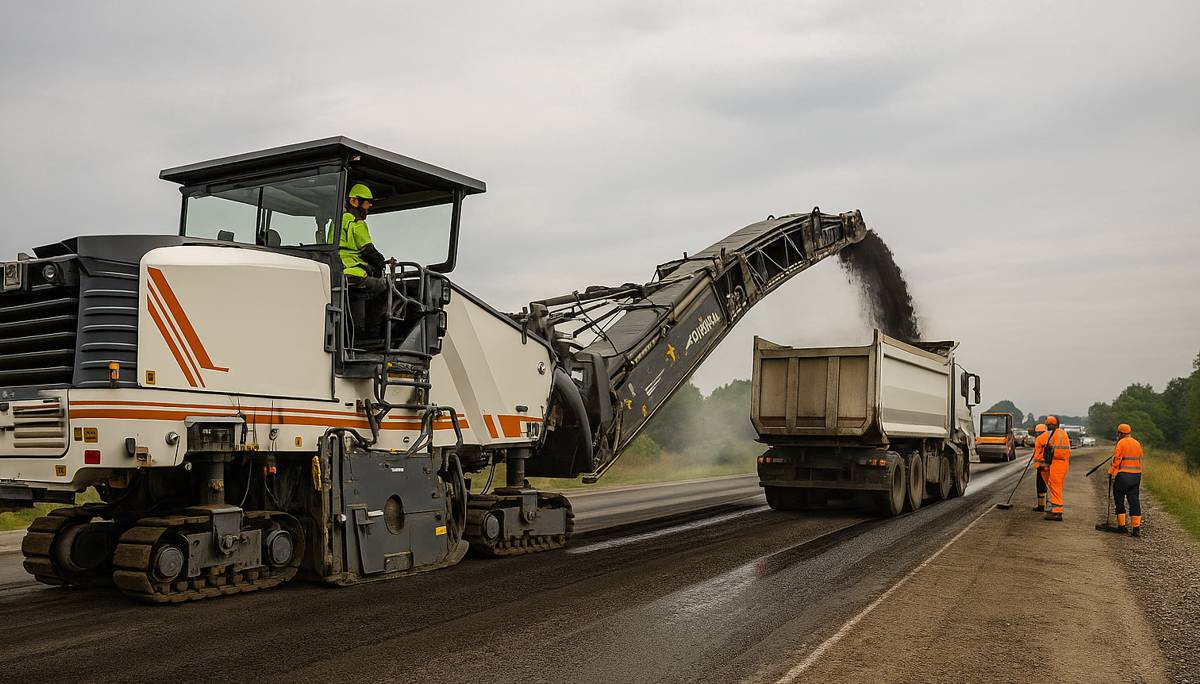
Towards Low-Carbon and Circular Asphalt
One of the biggest advantages of asphalt is how readily it can be recycled and reused. When a road is resurfaced, the old asphalt layer is typically milled off. Instead of treating that as waste, it can be melted down and incorporated into new asphalt mixes. In theory, today’s roads could be 100% recycled into tomorrow’s roads, a perfect closed-loop. In practice, while fully recycled asphalt pavement (RAP) is rare, many jurisdictions routinely use asphalt mixes with 30-50% recycled content, and some pilot projects have demonstrated asphalt made with 100% RAP successfully.
Every bit of reclaimed asphalt that is reused means less virgin bitumen needed (saving on petroleum) and less new aggregate to quarry. This can translate into major carbon savings. Christopher Elofsson, a project manager at Skanska’s asphalt plant in Sweden, notes that “recycling old asphalt reduces CO₂ emissions in the production of new asphalt by up to 50 percent”. His facility is engineered to use up to 100% recycled asphalt in new mixes, essentially treating old pavement as a stockpile of raw material rather than construction debris.
Around the world, the trend is toward increasing the RAP content in asphalt mixtures without sacrificing quality. High-RAP mixes require careful control (since the aged binder can be stiffer), often rejuvenators or softer new binders are added to ensure the final product meets specs. But the technology is proven, countries in Europe and North America have incorporated RAP at scale for decades, and with modern processing, even circular highways (built almost entirely from recycled roadway materials) are on the horizon.
Another key strategy for a lower-carbon footprint is switching from traditional hot-mix asphalt (HMA) to warm-mix asphalt (WMA). Warm-mix technologies allow asphalt to be produced and laid at temperatures typically 20-40 °C lower than hot-mix, by using additives (like special waxes, chemical surfactants, or foamed water) that improve workability at lower heat. By not heating the materials as much, fuel consumption drops and so do emissions of CO₂, aerosols, and fumes.
It’s common to see energy savings of 20% or more with warm-mix methods. This also has practical benefits: crews working with slightly cooler asphalt face lower risks of burns and inhale fewer fumes, and paved sections can often be opened to traffic sooner because they cool and harden faster. Many countries have recognized these advantages, for instance, the UK developed a low-temperature asphalt product called “Vialow” that can be produced ~40 °C cooler than standard mixes, yielding about a 20% reduction in embodied carbon.
Major suppliers in Europe now offer warm-mix as default; by 2020, over 40% of asphalt in some European countries was produced as warm-mix instead of hot-mix. Worldwide, warm-mix adoption is steadily growing, often spurred by government incentives or requirements, since it’s one of the lowest-hanging fruits for cutting asphalt’s carbon footprint. As Carl Platt, Director of Asphalt at CEMEX Europe, put it, these low-carbon asphalt ranges not only slash emissions but also “offer improved safety and efficiency, with increased shift outputs and earlier reopening to traffic”, making them an easy sell to contractors and clients alike.
Beyond recycling and lower energy processes, the asphalt world is exploring more radical departures from convention, namely, changing the ingredients that go into asphalt. Bitumen binders can be made greener by blending or substituting with renewable, non-petroleum components.
Researchers and companies are developing bio-based binders derived from sources like algae, vegetable oils, forestry by-products, agricultural waste, and more. In Sweden, for example, an experimental asphalt nicknamed “Asfalt Zero” uses a binder partly made from tall oil pitch, a resinous residue of the pulp and paper industry (essentially a pine tree oil), blended with conventional bitumen. The resulting pavement behaves like normal asphalt, but a chunk of the fossil content has been replaced by a renewable material. A quirky bonus: when this bio-asphalt is laid, it supposedly emits a pleasant pine smell instead of the usual tar odour.
Across Europe, dozens of bio-asphalt trials are underway, using binders from waste cooking oil, soybean or sugar beet residue, corn stover, lignin (from wood), and even algae blooms. The appeal is obvious, if we can gradually decouple asphalt from crude oil and use binders that are part of the contemporary carbon cycle (plants absorbing CO₂ then being turned to roads), the climate impact of paving could drop dramatically. Abubeker Ahmed and Jiqing Zhu of the Swedish Road Institute note there is “a big future for bio-asphalts” if they can meet performance standards, though they caution that each bio-source has different chemistry and extensive testing is needed to ensure they match the flexibility, adhesion, and longevity of traditional bitumen.
Early results are promising: some bio-binders have shown they can be “as durable, or more durable, than traditional versions,” according to Ahmed, even under harsh conditions. With further R&D, bio-bindings could allow roads to be built with minimal fossil carbon, while also providing a use for waste from agriculture or forestry. This also hedges against a future where, as the world uses less oil for fuel, the supply of petroleum bitumen might dwindle, in a decarbonizing economy, tomorrow’s road binders might come from farms and forests rather than oil wells.
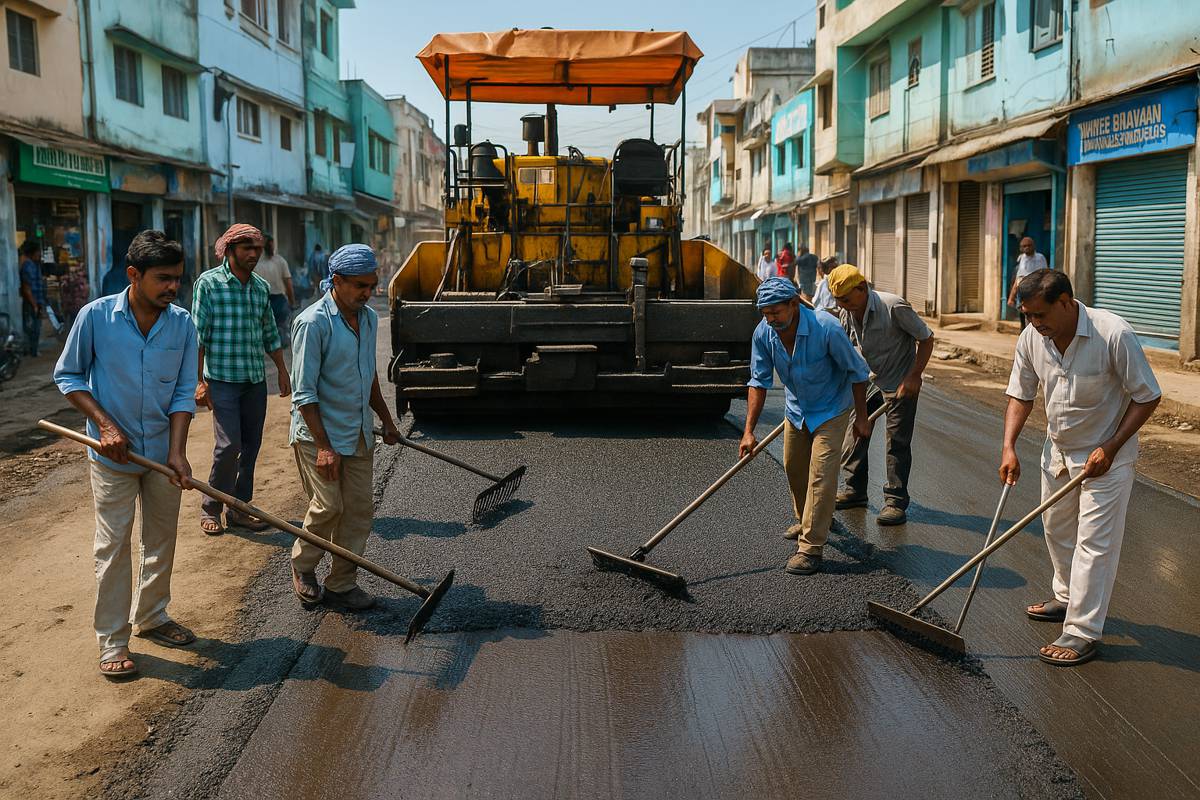
Plastics, Rubber, and Sugarcane
Another transformative innovation is the reuse of waste materials in asphalt mixtures, effectively turning roads into repositories for other industries’ by-products. The most publicized example is plastics. Many countries face a mounting crisis of plastic waste, and at the same time need durable roads.
Engineers in India were among the first to marry these problems with a single solution: plastic roads. Starting in the early 2000s, Indian researchers developed a technique of shredding waste plastic (bags, packaging, bottles) and mixing it into hot aggregate before adding bitumen. The plastic melts and coats the stone, acting as a supplemental binder that improves adhesion and water resistance. One early pilot was a street in Chennai in 2002, paved with a plastic-modified asphalt.
Over a decade later, that street had no potholes or cracks despite heavy monsoon rains and heat, outperforming neighbouring conventional roads. Impressed by such results, India’s government in 2015 mandated that major road projects near cities must use waste plastic in their asphalt mix. By 2021, at least 703 km of national highways in India were laid with plastic-infused asphalt, not to mention tens of thousands of kilometres of local city roads across 11 states. Each kilometre of road can consume roughly 1 ton of waste plastic, which is the equivalent of millions of plastic bags that would otherwise pollute land or ocean. Not only does this shrink landfills, but it displaces a portion of bitumen (saving petroleum) and has climate benefits: one analysis estimated that 1 km of road paved with waste plastic could save ~3 tons of CO₂ emissions compared to incinerating that plastic or using all-virgin asphalt materials.
There are added performance benefits too, plastic-modified asphalt tends to have a higher softening point, meaning it can endure higher temperatures before getting sticky, a boon in hot climates. It also can improve flexibility, reducing crack formation. Little wonder that what began in South Asia has spread internationally: trial plastic roads have been laid in countries from South Africa to the Netherlands, the UK, Indonesia, and more.
A Scottish company, MacRebur, commercialized a processed plastic additive for asphalt and completed projects across Europe, demonstrating that carefully prepared recycled plastic can slot into existing asphalt plants and practices. There are ongoing studies into long-term effects (for instance, ensuring that plastics in roads don’t leach microplastics into runoff), but so far the concept looks like a win-win: better roads and less waste.
Old vehicle tires, another huge waste problem, are also finding their way into roads. Ground-up scrap tire rubber, known as crumb rubber, can be blended into bitumen or asphalt mix to create rubberized asphalt. This has been successfully used in parts of the US (like Arizona and California) for decades. Rubberized asphalt can make roads quieter (the rubber particles dampen tire noise) and more resistant to cracking (the rubber imparts elasticity).
In essence, it boosts the pavement’s resistance to the aging and brittleness that cause cracks, while recycling a difficult waste product (tires) that would otherwise sit in landfills or be burned. Many highway agencies now allow or prescribe asphalt rubber for surfaces where reducing traffic noise is desired. Beyond plastic and rubber, researchers have experimented with incorporating other wastes: for example, steel slag (a by-product of steelmaking) and coal fly ash (from power plants) have been used as partial replacements for the mineral aggregate in asphalt. These can improve certain properties (slag can enhance skid resistance, fly ash can fill voids) and again reduce the need for virgin materials.
An innovative trial in Brazil uses sugarcane waste, the ash from bagasse fibres, as a filler in asphalt, yielding a pavement that is stronger and more sustainable.
One particularly sweet innovation comes from Brazil, the world’s largest sugar producer. Brazil generates millions of tons of sugarcane bagasse (the fibrous leftover after crushing cane for sugar or ethanol). Traditionally, bagasse is burned for energy at sugar mills, leaving behind a fine bagasse ash, often treated as waste. But engineers at the State University of Maringá (UEM) found that this ash can replace a portion of the mineral filler (stone dust) in asphalt mix.
In a pioneering project, they formulated an asphalt with about 5% of the aggregate replaced by sugarcane bagasse ash and found it not only met all the technical requirements but actually improved performance. Lab tests showed roughly a 40% increase in Marshall stability (a standard measure of asphalt strength) and higher tensile strength when using the ash-modified asphalt. In practical terms, that means the pavement can handle heavier loads and harsher conditions without deforming. In fact, in accelerated trafficking tests, sections with bagasse ash showed a 73% higher resistance to deformation and 28% less permanent rutting under heavy truck traffic compared to conventional asphalt. Such improvements are significant for road longevity.
The innovation isn’t just about strength, though, it’s also a big environmental win. By substituting waste ash for some of the quarried stone dust, the asphalt requires less mining of new materials and finds a use for an abundant agricultural waste. Producing and hauling mineral filler has a carbon and energy cost; by contrast, sugarcane ash is already available as a by-product in cane-growing regions. Every ton of bagasse ash used in pavement is a ton diverted from landfills or stockpiles (where it would sit uselessly, and potentially leach contaminants). The Brazilian team calls it a “virtuous cycle”, turning an agro-industrial waste into a resource for construction, while simultaneously cutting down on the need for new raw materials. Even economically, it’s attractive: bagasse ash is basically free (a waste product), whereas stone dust costs money to produce and transport. The researchers reported that using cane ash actually lowered the overall cost of the asphalt mix, all while boosting performance, a rare case where the greener option is also cheaper.
After promising lab results, the Brazilian team took the bold step of testing sugarcane asphalt on a real highway. In 2023, a stretch of the BR-158 highway in Paraná state, a busy route for farm goods, was paved with the bagasse-ash-modified asphalt alongside conventional pavement for comparison. The trial section was constructed with normal paving equipment and methods, proving that the new mix could be integrated into practice without issue.
The outcome has been “resoundingly positive”, the sugarcane asphalt section is performing even better than expected under daily traffic, validating that the lab gains translate to real-world durability. This success attracted international attention when the research was published in a Scientific Reports journal article, lending credibility and transparency to the findings. It’s a textbook example of synergy between sustainable infrastructure and agriculture: Brazil’s economy, which heavily relies on agribusiness, could directly benefit by using an agricultural residue to reinforce the very roads that carry farm products to market.
Instead of a problematic waste (bagasse ash can contain some heavy metals and has little fertilizing value), the sugar industry gets a new revenue stream supplying ash to road builders. On the other side, road agencies get a stronger pavement material without relying solely on non-renewable resources. Given that for each tonne of sugarcane processed about 6 kg of ash is produced, the scale of potential is enormous, Brazil produces on the order of 3 million tonnes of bagasse ash per year, enough to supply a lot of road projects if fully utilized.
The Brazilian sugarcane-asphalt story underscores a broader point: innovative use of local waste materials can address multiple challenges at once, managing waste, improving roads, and reducing costs, a true sustainable development win-win. It has inspired interest in other sugar-producing countries (like India, Thailand, and others) which have done lab research on bagasse in asphalt, though Brazil’s full-scale field trial sets it apart as a leader in this niche. Calls are now growing to scale up the use of sugarcane ash asphalt across Brazil’s highway network, especially on critical freight corridors in agricultural regions where tougher roads are badly needed. Using “farm-to-road” materials could ensure the farm-to-market roads themselves don’t become the weak link in the supply chain.
To make it routine, standards and specs will need updating, supply chains must be organized (sugar mills partnering with asphalt plants), and road authorities need continued confidence in the material. Ongoing monitoring of the pilot section will provide valuable performance data. But so far, all signs point to success, as the research team noted, “it’s a solution that has everything to be adopted on a large scale”, and each additional successful project will chip away at scepticism. Sometimes, the answer to big problems is hiding in plain sight (or in this case, in heaps of agricultural ash), it just takes creativity and courage to try it on the ground.
The road ahead in Brazil may literally be paved with sugar, and it exemplifies how the asphalt of the future can incorporate all manner of recycled and renewable ingredients.
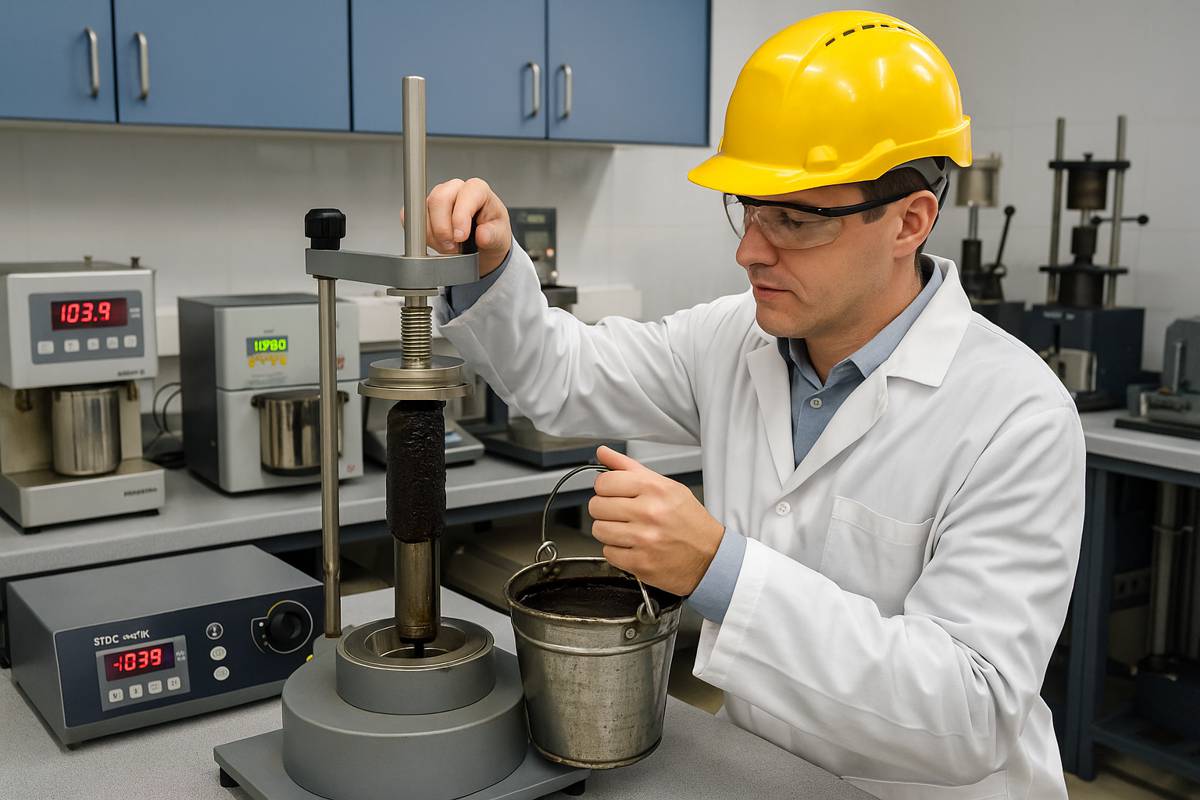
Enhancing Durability and Longevity of Asphalt Pavements
While much focus is on making asphalt greener, an equally important aspect is making it last longer. A more durable road means fewer repairs, less frequent repaving, and therefore less material consumption over time, a sustainability win in its own right. The durability of bituminous pavements depends on how the bitumen binder behaves over years of traffic and environmental exposure. Bitumen is a viscoelastic material, meaning it behaves partly like a viscous liquid and partly like an elastic solid, depending on temperature and loading rate. At high temperatures or under slow, sustained loads, bitumen flows more like a liquid; at low temperatures or under fast, sudden loads, it behaves more like a rigid solid.
This dual nature means asphalt is sensitive to its service conditions: hot climates or heavy slow loads can cause softening and rutting, while cold climates or heavy dynamic loads can cause cracking. Over time, bitumen also ages and becomes stiffer and more brittle. There are two main aging processes: short-term aging occurs during mixing and construction (when hot bitumen is exposed to air, some volatile components evaporate and oxidation begins). Then long-term aging continues for years as the pavement is in service, oxygen reacts slowly with the binder and UV radiation, and heat further oxidize it, steadily increasing stiffness and reducing flexibility. An aged asphalt binder can make the pavement prone to cracking (since it can’t flex as easily under loads or thermal contraction).
To combat these issues, highway engineers and researchers have developed a host of modifications and additives to enhance asphalt’s resistance to deformation and cracking. The most common are polymer modifiers: adding a few percent of polymers like SBS (styrene-butadiene-styrene) or EVA (ethylene-vinyl acetate) to the bitumen dramatically improves its high-temperature performance and elasticity.
Polymer-modified bitumen (PMB) has become standard for heavy-duty highways and airport runways because it can handle high heat without turning too soft, and it remains elastic at low temperatures, thereby reducing thermal cracking. Another approach is adding crumb rubber (from recycled tires) into bitumen, rubber not only boosts elasticity and viscosity (helping resist rutting), but also has an anti-aging effect as it can absorb some of the oxidizing components, slowing the stiffening process.
Nanomaterials have also entered the scene: researchers have experimented with nano-sized additives such as nano-silica, titanium dioxide nanoparticles, and even graphene nanoplatelets to enhance bitumen. These can improve stiffness at high temperatures, improve rutting resistance, and even add UV resistance (TiO₂ is known for that). Graphene, being one of the strongest materials known, has shown promise in reinforcing asphalt and prolonging fatigue life by preventing micro-crack growth. Though still relatively expensive, nano-modified asphalts may play a bigger role in the future as costs come down.
To illustrate, a variety of case studies have shown the benefits of these modifications. Roads with SBS-polymer modified asphalt show significantly improved resistance to rutting in hot weather and better flexibility in cold, translating to fewer cracks. Projects incorporating crumb rubber have reported pavements with reduced rutting and improved flexibility, particularly useful in regions with extreme day-night or seasonal temperature swings that normally cause cracking. In Italy and the UK, trials with graphene-enhanced asphalt have indicated the potential for markedly longer lifespans (some claiming double the lifespan) due to better resistance to both rutting and fatigue cracking, although such claims are being verified over time.
Even self-healing asphalt is being explored: for example, adding tiny steel wool or fibres into asphalt so that, when a microwave or induction machine is passed over the pavement, the fibres heat up and “heal” micro-cracks by re-melting the surrounding bitumen. The Netherlands has led some fascinating pilots where induction heating every few years extended pavement life by sealing cracks before they grew. It’s still experimental, but it shows the innovative thinking on prolonging pavement life.
Alongside modifiers, additives are used to address specific durability issues. Anti-oxidant additives (like lead diamine or certain bio-oils) can slow the aging of bitumen by chemically inhibiting oxidation. Anti-stripping agents (often amine compounds) are added to ensure the bitumen sticks well to aggregates even in the presence of water, preventing moisture damage and potholes from water infiltration.
Fibre additives (such as cellulose fibres or fiberglass) can reinforce the asphalt mix, helping it hold together under strain and reducing cracking in high-stress areas (fibres are commonly used in stone-matrix asphalt to stabilize the mix). By using the right combination of polymer modification, crumb rubber, nanomaterials, and additives, modern asphalt mixes can be tailored to very demanding conditions, for instance, ultra-durable airfield pavements that resist jet fuel spills and extreme tire shear, or heavy-load truck corridors that resist rutting under slow traffic in high heat.
Of course, ensuring durability also relies on rigorous testing and specifications. All over the world, standards organizations have developed tests to characterize bitumen and asphalt so engineers can predict how they will perform. Traditional tests include the penetration test (measuring bitumen hardness by how far a needle penetrates a sample under set conditions), the ductility test (how far a bitumen sample can stretch when pulled before breaking, indicating its flexibility), and the softening point test (determining the temperature at which a bitumen sample softens enough to let a steel ball drop through, which tells us the heat tolerance of that binder). For example, harder binders with lower penetration values are chosen for hot climates so they don’t turn too soft, while binders that retain ductility at low temperatures are important for cold climates to avoid brittle cracking.
Modern performance grading systems, like the Superpave PG system used in the U.S., rely on advanced rheological tests: the Dynamic Shear Rheometer (DSR) measures a binder’s viscoelastic properties (stiffness and phase angle) at various temperatures to ensure it meets criteria for high-temperature rutting resistance and intermediate-temperature fatigue resistance. The Bending Beam Rheometer (BBR) checks how stiff the bitumen is at low temperatures and how it relaxes under load, to predict thermal cracking performance. There are also aging simulations: the Rolling Thin-Film Oven Test (RTFOT) simulates short-term aging by heating bitumen in a thin film with air exposure (approximating what happens during mixing and paving). The Pressure Aging Vessel (PAV) then simulates long-term aging by pressurizing and heating the binder to mimic 5-10 years of in-service aging. By comparing properties before and after these aging tests, researchers can tell how much a binder hardens and choose formulations that age more slowly.
Different regions have their own standards, for instance, Europe uses the EN specifications: e.g. penetration grade bitumen might be labelled 50/70, meaning a moderate hardness suitable for temperate climates; the Fraass Breaking Point test (EN 12593) is a specific low-temp brittleness test to ensure a binder won’t crack at a certain cold temperature. Yet, despite different test methods, the goals are the same globally: to ensure the bitumen and asphalt mix chosen will perform under the expected climate and traffic.
Thanks to these tests, today’s asphalt engineers have a deep understanding of material behaviour and can design longer-lasting pavements. The continued development of new modifiers, coupled with advanced characterization techniques (like nano-scale imaging of binders, or computer modeling of asphalt microstructure), promises even more durable and resilient roads in the future.
The mantra is clear: prevent distress before it starts, whether by using sturdier materials, keeping water out, or giving the asphalt self-healing abilities, so that the roads of tomorrow significantly outlast those of today.
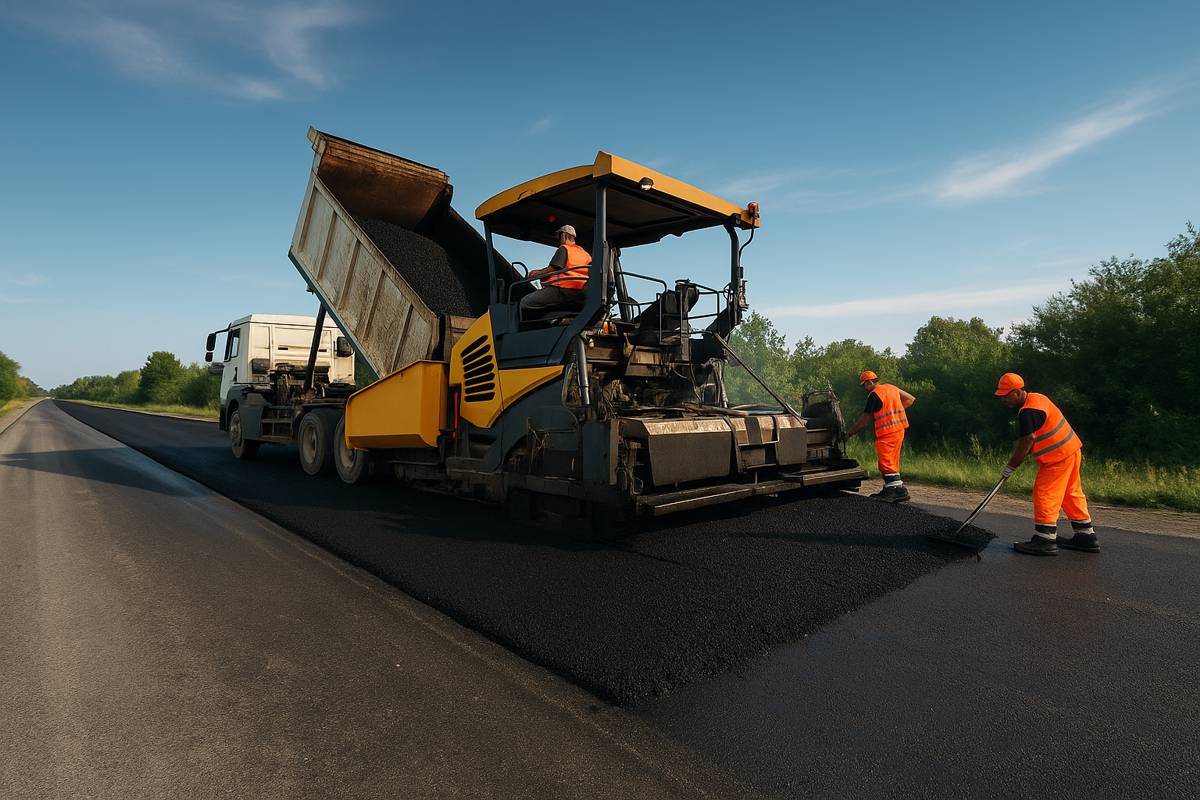
Global Initiatives for the Road Ahead
All of these innovations, from low-carbon asphalt to high-performance binders, are gaining momentum, but to truly transform road infrastructure at a global level, supportive policies and industry initiatives are crucial. Fortunately, that shift is well underway. Governments across the world are beginning to steer road construction toward sustainability. In the United States, for example, the federal government has put serious funding behind greening highways. The 2021 Bipartisan Infrastructure Law and Inflation Reduction Act included programs targeting low-carbon materials: the Federal Highway Administration launched a $2 billion program to help state and local agencies adopt cleaner construction materials such as green asphalt, low-carbon concrete, and recycled steel.
In 2024, $800 million in grants were made available to cities, tribes, and counties specifically to try low-carbon pavement technologies. Announcing the effort, the U.S. Transportation Secretary emphasized providing “the best transportation at less cost to the environment,” and FHWA’s Administrator framed it as ensuring America’s infrastructure investment also drives a market for sustainable products. These grants encourage things like using warm-mix asphalt, higher recycled content, or alternative binders by covering any cost premiums and funding pilot projects.
The U.S. is also moving toward requiring Environmental Product Declarations (EPDs) for asphalt and other materials in federal-aid projects. EPDs are like nutrition labels for carbon footprint, by demanding them, agencies can compare suppliers and push contractors to reduce emissions. Even traditionally conservative state DOTs have started to include sustainability criteria in their tenders, such as extra points for using RAP above 20% or penalties if you don’t offer warm-mix options. In short, public procurement is being used as a lever to mainstream greener asphalt.
Over in Europe, the push is, if anything, more formalized. The EU’s Green Public Procurement guidelines encourage choosing designs and materials with lower environmental impact, which many member countries have translated into road-build specs. Warm-mix asphalt is now mandated or default for highway projects in many European countries unless there’s a special reason to use hot-mix, given warm-mix’s clear benefits in energy and emissions.
Several EU nations have launched national “road maps” for circular roads, the Netherlands, for example, has showcased highway projects with 60-70% recycled asphalt content and bio-based binders as part of its drive toward a circular economy. France has started evaluating carbon footprints as part of bid criteria for road contracts, effectively compelling contractors to use techniques like low-energy asphalt and recycled aggregates to stay competitive. Standards bodies like CEN (European Committee for Standardization) are updating asphalt standards to account for warm mixes and alternative materials so that these can be specified with confidence across Europe. The UK has set particularly ambitious goals via its highway agency (National Highways): it announced that by 2040 all road construction and maintenance for the strategic road network will be net-zero in emissions. Interim targets include phasing out fossil-fuelled equipment and switching entirely to low-carbon materials like warm-mix or bioasphalt well before 2040.
As Nick Harris, the Chief Executive of National Highways, put it, “we’re pledging to take carbon out of roads,” sending a clear signal to the supply chain that if you want to work on Britain’s motorways, you need to bring climate solutions. Already, a trial in Yorkshire delivered the UK’s lowest-carbon road resurfacing ever, using 100% recycled aggregates, low-temperature binder, and plant-based additives, effectively a “near net-zero” asphalt project that demonstrated these methods can work at scale.
Emerging economies, where a lot of new road construction will happen this century, are also finding ways to join the sustainability movement. India’s plastic road mandate (mentioned earlier) is a prime example of aligning infrastructure expansion with environmental clean-up. China, which has the world’s largest expressway network, is pouring research into low-carbon pavement as part of its Belt and Road Initiative, Chinese studies have examined how future climate warming could affect pavement performance and are urging proactive design changes now.
Often, international development organizations are helping: the World Bank and other multilateral lenders now finance many road projects with strings attached for sustainability. For instance, the World Bank funded pilot waste-plastic roads in Bangladesh both to tackle plastic pollution and to see if the plastic-modified asphalt better survives the country’s severe monsoon flooding. Early reports from a village in Bangladesh show the polymer-enhanced asphalt is indeed more resilient to flood damage, a promising sign for wider adoption in climate-vulnerable regions.
On the industry side, collaboration and knowledge-sharing have ramped up. The European Asphalt Pavement Association (EAPA) and its counterparts (like the National Asphalt Pavement Association in the US) regularly publish guides on lowering the carbon footprint of asphalt production, from improving energy efficiency at plants to maximizing RAP usage and transitioning to renewable fuels for asphalt plant burners. Major companies are investing in R&D: for example, Shell (a major bitumen supplier) has research programs on bio-binders and rejuvenators, and big road contractors (such as Eurovia, Vinci, or Colas) are testing technologies like self-healing asphalt with induction-heating steel fibres, or even solar roads that embed photovoltaic cells in the pavement.
While some of these ideas are experimental or in early stages, the flurry of innovation shows an industry trying to reinvent itself. Alliances and initiatives are forming to pilot new solutions, from coalitions to increase the use of recycled shingles (roofing waste) in asphalt, to initiatives for electrifying construction equipment used in road building.
Crucially, the economics of road building are starting to change in favour of sustainability. What used to be externalities, the carbon emissions, the societal cost of waste, are increasingly being assigned real costs or incentives. If a government is willing to pay a bit extra for low-carbon asphalt (through grants or bid preferences), companies will innovate to win the job. In many cases, though, the supposedly “green premium” is shrinking or even reversing: using recycled asphalt saves money because you buy less new bitumen and aggregate; using warm-mix saves fuel; building a longer-lasting road saves on maintenance costs.
So the business case for these improvements is getting stronger. Yes, new technologies or materials can have higher upfront costs (for example, a pilot of a novel bio-binder might cost more initially), but as they scale up, costs tend to drop. And there’s a looming fact that high-carbon practices may soon face penalties, whether through carbon pricing, stricter regulations, or project requirements, making early adoption a wise competitive move. The bottom line is that sustainable roads are increasingly seen as the smart investment: they pay off over time in both environmental and economic terms. The asphalt industry has read this writing on the wall “innovate to survive in a low-carbon economy”, and it is rising to the challenge.
As we look to the future, the road ahead for bitumen and asphalt is being reshaped by necessity and ingenuity. We are likely to see a mix of incremental improvements and breakthrough innovations. Incrementally, many of the solutions discussed are ready today: increased recycling, warm-mix technology, better modifiers, and waste additives could be rolled out almost anywhere now to immediately cut emissions and extend pavement life. The challenge is more about policies and awareness to accelerate widespread adoption. In parallel, cutting-edge research continues for the next generation of roads, from advanced bio-binders that might entirely replace petroleum bitumen, to smart pavements that can heal themselves or interact with electric vehicles.
Conceptual ideas like roads that charge EVs inductively as you drive, or solar panel roads that generate electricity, are being tested in small pilots (e.g., in Italy and France for inductive charging, in France and China for solar roads). These are in their infancy and have challenges (cost, durability, safety), but they illustrate a fundamental shift in thinking: the road is no longer just a static strip of material; it could be an active, multifunctional part of infrastructure, generating power, communicating data, or repairing itself.
Ultimately, meeting our global transportation needs and our climate goals will require both conservation and innovation. Conservation in the sense of using materials wisely, maximizing reuse (so today’s asphalt truly becomes tomorrow’s “black gold” to be mined and re-mined), extending the life of roads so we rebuild them less often, and being strategic about new construction. Innovation in the sense of deploying new tech and techniques, from the lab to the field, to reduce emissions and improve performance. It’s often said that the greenest road is the one you don’t build, and indeed, many cities are rethinking highway expansions and car dependence. But for the roads we do need, we can ensure they are as green and resilient as possible.
The encouraging news is that around the world, this transition is already underway. Engineers are “brightening, cooling, draining, and reimagining” the blacktop; they’re melting down yesterday’s pavements to form tomorrow’s, proving we can pave in a circular loop instead of a wasteful line. Factories are experimenting with binders that smell of pine trees or incorporating pellets of recycled plastic that would have otherwise choked landfills. Each successful demonstration, whether it’s a near-zero-carbon repaved highway in England, a plastic road surviving monsoons in India, or a sugarcane ash highway in Brazil, chips away at scepticism and builds confidence that new approaches work.
In a broader sense, there is a cultural shift: asphalt paved roads, once an unquestioned symbol of progress, are now being scrutinized for their environmental impact. This doesn’t mean we stop building roads, but it means road builders must prove they are contributing to a sustainable future, not detracting from it. The asphalt industry is increasingly leaning into this challenge, embracing recycling, cutting emissions, and positioning roads as part of the climate solution rather than the problem. And because the global road network is so vast, even small improvements scaled across millions of miles can yield enormous benefits. Many of the needed changes are not futuristic at all; they are proven technologies just waiting to be scaled up. With strong policy nudges, investment in R&D, and public awareness, the pace of adoption can accelerate.
Standing at this crossroads (pun intended), one thing is clear: the way we pave the world is changing. The humble mix of rocks and tar beneath our tires is getting a climate-conscious makeover. The next time you drive on a fresh smooth road, consider what might be beneath you: perhaps a blend of recycled old pavement, reinforced with ground tires and waste plastic, held together by a bio-oil binder, and soon, it could even be quietly charging your electric car or soaking up the rain to prevent floods. This isn’t science fiction but an emerging reality as the global community works to decarbonize and adapt our infrastructure.
Bitumen and asphalt may be traditional materials, but they are proving remarkably adaptable. Through a combination of ingenuity, investment, and sound policy, the world’s roads are poised to become greener, more resilient, and smarter than ever before. The journey toward sustainable roads is well underway, and every innovative project, every greener mix, is paving the way to a more resilient future.
